The Warriors' Finest
In the name of God, Amen. On the day of Venus (Friday), the 28th of July, in the year of the Lord 1402, I , Thomas Boynton, knight, of sound mind and memory, set down my will as follows. First, I bequeath my soul to almighty God, to blessed Mary, and to all the Saints, and my body to be buried in the church of Acclom. . . . Likewise that the executors arrange for my armament with the Prior and Monastic Community of Gisburn. [Testamenta Eboracensia, pp. 286-87]
Thomas was a knight -- as was his father and his father before him and all the way back to Walter who lived in the twelfth century. And he was a warrior [A Boynton Story: Introduction to Feudal Warlord]. When Thomas wrote his will in 1402 he left his soul to God, his body to the church at Acklam, and his armor to the Priory at Guisborough.
Thomas wore armor. What did it look like? Walter, William and Ingram wore armor two centuries earlier. What did it look like? There is not much armor around from the twelfth and thirteenth centuries. However, there are two other ways to know what the armor looked like -- effigies and brasses. The leaders of England had a hankering for immortality -- here as well as in the hereafter -- so they had remembrances of themselves created. And they wanted to be remembered as warriors. So the effigies and brasses dress them in armor, and we can look at these representations of their favorite attire.
The effigies are taken from two articles by William M. I'Anson that were published in the Yorkshire Archaeological Journal in the 1920s.
Walter, William and Ingram
Father, son and grandson -- they lived in the twelfth century and the first half of thirteenth century. Walter was deputy sheriff of Yorkshire in 1201 and was in charge of the king's castle in York. He would have needed armor for that duty. William and Ingram were involved in the revolt against king John that resulted in the magna carta, and they would have needed armor for that [A Boynton Story: Magna Carta -- Father and Sons]. They may have needed armor on many other occasions, but these are the ones we can be confident about.
I'Anson claimed that there were, in the 1920s, no effigies in Yorkshire from before the middle of the thirteenth century. He did supply pictures from other parts of England for that time.
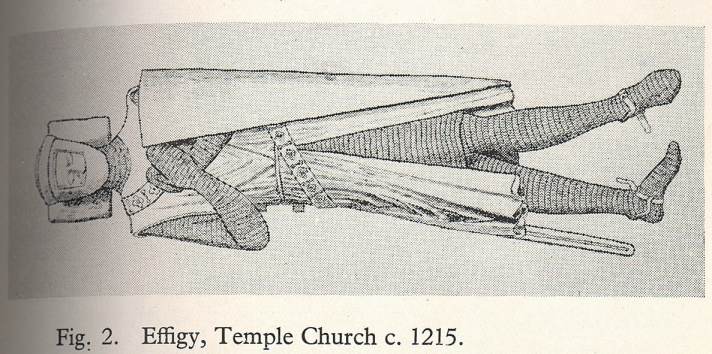 |
The effigies were displayed on a tomb, and the knight was sculpted as lieing on the tomb. Most, including this one from 1215, had a pillow under the knight's head.
The knights first donned padding, and then slipped on their suits of mail. The mail covered them from head to toe. At this early point the mail was fitted rather like a skirt. Over the mail they wore a cloak that was primarily for decoration; the cloak was often decorated with the arms of the knight. At the beginning of the thirteenth century the shield was made of wood and covered with leather. This shield is very long and pointed, which was the standard of the day. The knight also has a sword belted on.
Ingram
Ingram, the grandson of the Ingram of the first half of the thirteenth century, was called up by Edward I for conquering the Welsh.
The effigy from this period, 1270, is of Sir John Bulmer. The Bulmers were a distinguished family in Yorkshire at the time.
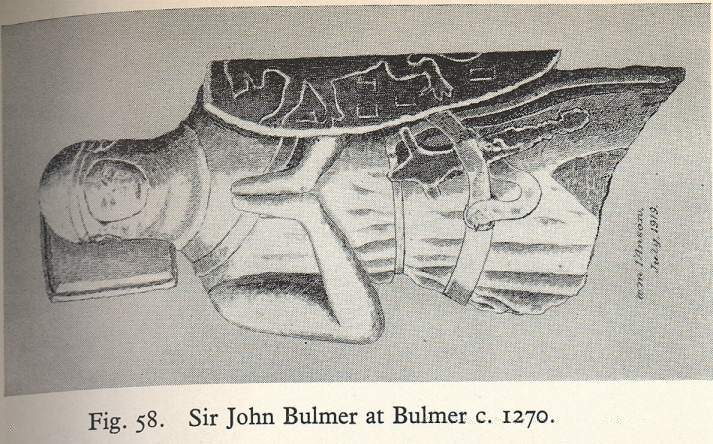 |
The rounded shape of the helmet is different from the earlier helmet. The shield is shorter and more highly decorated. The knight is sculpted with his hands pressed together as if in prayer. And the legs are missing so changes in the form of the mail are not visible.
Ingram served in the army against the Welsh, at least in part, because of the land he held from the Fauconbergs which his grandfather had acquired. There is a William Fauconberg effigy from 1294.
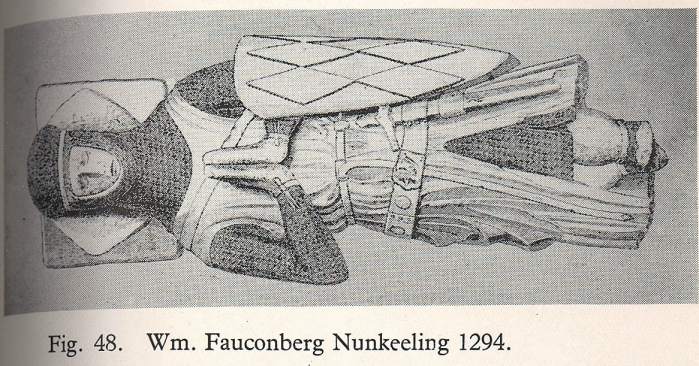 |
The legs are missing again. The sword is hung in front, but is broken off. The knight's hands are again clasped as if in prayer. And the shield is again shorter and more highly decorated than earlier in the century.
Robert, John, Edmund, and Ingram
Robert, John, Edmund -- the Boyntons of Boynton -- and Ingram -- of the Boynton triangle -- where all involved in chasing Gaveston and the king, Edward II, around Yorkshire early in the fourteenth century [A Boynton Story: Caught in the Middle]. They were also involved in Edward's debacle, Bannockburn [A Boynton Story: Surviving Bannockburn]. They needed armor for these military operations as well as others in which they were involved.
The Boyntons and the Conyers had close connections over the centuries. Thomas married a Conyer daughter later in the century. This effigy is of Sir John Conyers of Sockburn.
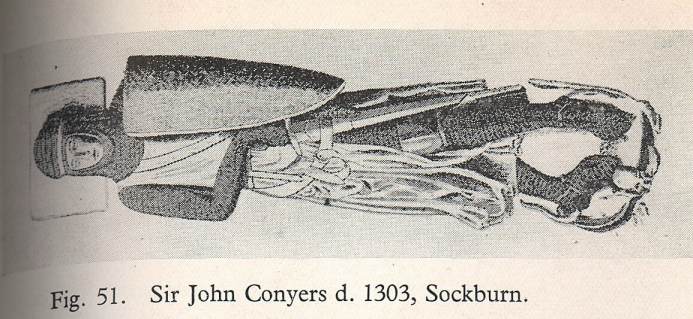 |
The sword is hanging in front. The mail is now split for riding. And there is a protection for one knee, showing, made of plate metal. Plate will become an increasingly important element in armor over the fourteenth century.
Bannockburn was 1314, and a Mowbray was in charge of Stirling castle. This effigy is a different Mowbray, but the same family.
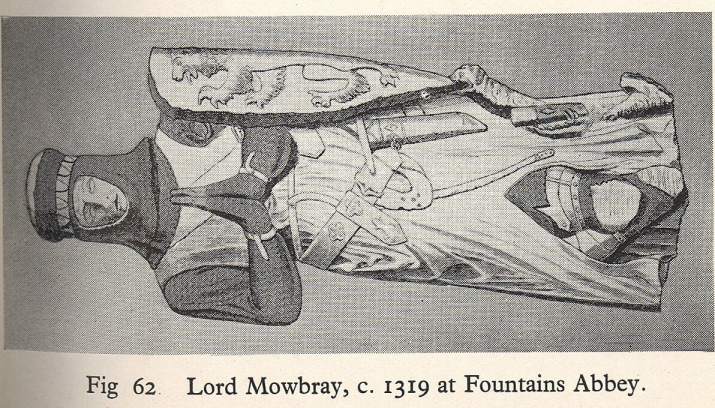 |
When the English knights charged off to Scotland to re-take Stirling castle they would have been attired in something like this or the Conyers armor.
Robert, Thomas and Henry
At the end of the fourteenth century Henry Percy, first earl of Northumberland, led the fight against the Scots. And Boyntons were lieutenants in these fights [A Boynton Story: Introduction to Feudal Warlord]. We would call it terrorism. The Scots would swoop down into northern England and steal goods, demand ransom, injure and kill, and then speed away. There were no large scale battles. It was guerrilla warfare.
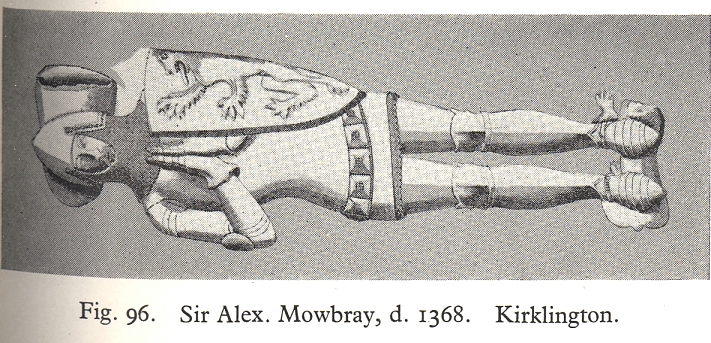 |
Between early in the fourteenth century and late in the century armor was undergoing a substantial transformation. Plate was adopted for armor in place of chain. On this effigy the legs are encased in plate with protection at the knees, elbows and shoulder. The only mail that is visible is protecting the neck of the knight.
Martin de la See
Martin de la See is a Boynton only by virtue of his daughter, Margaret, marrying a Boynton. However, there is an effigy for him in the Barmston church, which is a church that was the center of Boynton religious life beginning in the sixteenth century and continuing for several centuries. There are more records of Boyntons in the Barmston church than in the church at Burton Agnes, which Boyntons acquired at the end of the seventeenth century.
Martin was lord of the manor of Barmston, and Margaret was his heir. When Margaret married Robert de Boynton it approximately doubled the Boynton land holdings. Martin died at the end of the fifteenth century.
 |
Martin is sculpted with his head on a substantial, though hollow, pillow and his feet resting on a dog. The armor is all plate rather than mail. There are protections for the knees and the shoulders. There is a belt that seems for wearing a sword, but there is no sword. There is also no shield.
We visited Barmston in 1999 and took this picture. The effigy and the tomb were in a very sad state of disrepair. When we were back in 2001 they were off being repaired.
Thomas and Henry
And now, Boyntons. Thomas was a Boynton triangle Boynton. His mother was Margaret de la See Boynton and his grandfather was Martin. Henry was a Sedbury Boynton who lived at about the same time. Thomas died at a rather young age in 1523. Henry died in 1531 at about sixty. Both had a brass made and placed in the church of their choice.
Thomas built the church at Roxby and was buried there [A Boynton Story: Roxby]. The brass is in the floor of the church. The brass of Henry and his wife Isabella is quite large and is displayed on the wall of the church at Gilling West. Henry did not build the church at Gilling West, but he was clearly an important member. He did establish a chantry, and this is the only monumental brass in the church. In addition to the brass there is tombstone in the floor where Henry was buried.
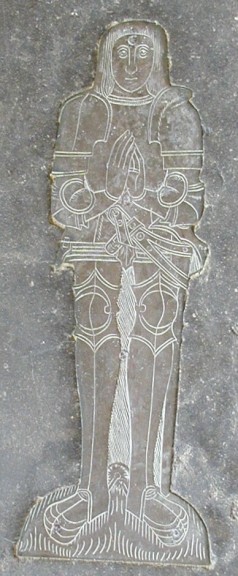 |
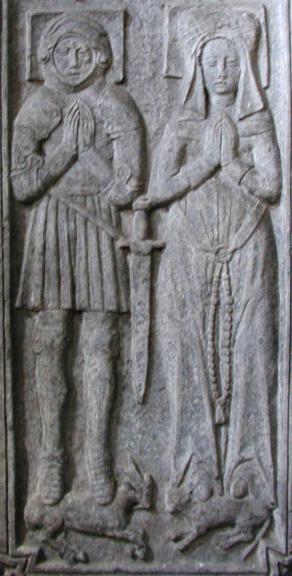 |
|
Thomas
|
Henry and Isabella
|
The brass of Thomas is barely sculpted; it is more like an outline drawing and is not very well proportioned. However, the features of the armor are quite distinct. The brass of Henry and Isabella is more sculpted, and they are in a more standard pose with pillows under their heads and their feet resting on an animal. The armor plate is clearly visible in both brasses. There is protection at the shoulders, the elbows and the knees, though the protection of the knees is more difficult to see on the brass of Henry. Henry's sword is clearly visible; Thomas had a sword which is now gone. Neither has a shield. Henry has a helmet, but Thomas is bare headed.
Sunday Go to Meeting Best
There was a time when we all put on our finest for Sunday, and we have wanted to be buried in our best suits. The same seems to have been operating in medieval England. We have no reason to believe that either Thomas or Henry ever fought in armor. There are no records of their being involved in warring. Henry was too young to participate in the war of the roses, which he otherwise would surely have taken part in, and Thomas was even younger. We cannot be certain, of course. But it looks like when it came time to be remembered they put on their "sunday best," which in their day -- and for many centuries earlier -- was armor.
They were feudal knights, lords of their domains. When the king called they went off to fight. When it came time to be remembered they wanted to be remembered as warriors.
 |
I'Anson, William M., The Mediaeval Military Effigies of Yorkshire (Part I), Yorkshire Archaeological Journal, vol. xxviii, 1924-1926, pp. 345-379.
I'Anson, William M. The Mediaeval Military Effigies of Yorkshire (Part II), Yorkshire Archaeological Journal, vol. xxvix, 1927-1929, pp. 1-67.
(1836) Testamenta Eboracensia or Wills Registered at York, from the Year MCCC. Downwards, part I, J. B. Nichols and son, pp. 286-287